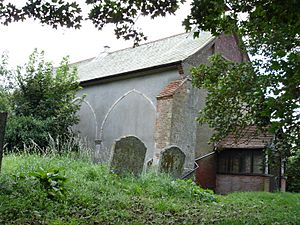St Mary's Church, Wix facts for kids
Quick facts for kids St Mary's, Wix |
|
|---|---|

St Mary's, showing the 13th-century arches on the north wall
|
|
| 51°55′04″N 1°08′41″E / 51.91777°N 1.14462°E | |
| Denomination | Anglican |
| History | |
| Status | Active |
| Founded | c. 1125 |
| Architecture | |
| Functional status | Parish church |
| Heritage designation | Grade II |
| Designated | 17 November 1966 |
| Specifications | |
| Bells | 1 |
| Administration | |
| Parish | Wix St Mary the Virgin |
| Diocese | Chelmsford |
St Mary's Church is an old Anglican parish church located in the village of Wix, Essex, England. It is a "Grade II listed" building, which means it is an important historical site. This church used to be connected to a priory, which was like a home for nuns, way back in the Middle Ages. Most of the church you see today was built in the 1700s.
Contents
The History of Wix Priory
The Priory of St Mary was a Benedictine nunnery, a place where nuns lived and prayed. It was started around 1125 by three siblings: Walter Mascherell, Alexander de Wix, and their sister Edith. Their father, Walter the Deacon, owned a lot of land in the area during the late 1000s and early 1100s.
The Priory's Early Days
The priory included a church that had been there since about 1050. Even though the priory was never very big, usually having only about ten nuns, it was quite important in the local area. The nuns owned large amounts of land in Wix and the surrounding countryside. The priory was like a manor, which meant it had its own land and rules. People who rented land from the priory had to do special work for it.
The Peasants' Revolt and the Priory
By 1381, during a time called the Peasants' Revolt, people were unhappy with these rules. During the revolt, angry villagers attacked the priory. They destroyed the "manorial rolls," which were important documents that listed all the work the villagers had to do for the priory. After the revolt ended, the head nun, called the prioress, made those responsible leave. She then made them pay a fine before they were allowed to return.
The Priory's Closure
The priory continued to operate until the 1500s, but it became quite run down. In 1525, a powerful man named Thomas Wolsey closed it down. This priory was one of 30 small religious houses that were shut to help pay for new schools. The money went to The King's School, Ipswich and a college in Oxford, which is now known as Christ Church. After it closed, the priory buildings were taken down, leaving only the church. The only parts of the priory that you can still see today are some old arches from the 1200s. These arches are now blocked up and form part of the church's north wall.
The Church's Later Years
The church itself was later repaired and mostly rebuilt in 1744. It was worked on again in 1888. Much of the original stone and rubble used to build it was replaced with brick. In 1966, the church was given its "listed status," recognizing its historical importance.
The Church Bell
The church has a special bell frame that stands on its own. It once held three bells, but now it has only one. This single bell is very old, dating back to the 1400s. In 1975, someone tried to steal the bell. Because of this, the old bell frame was replaced with a newer, more secure design.

